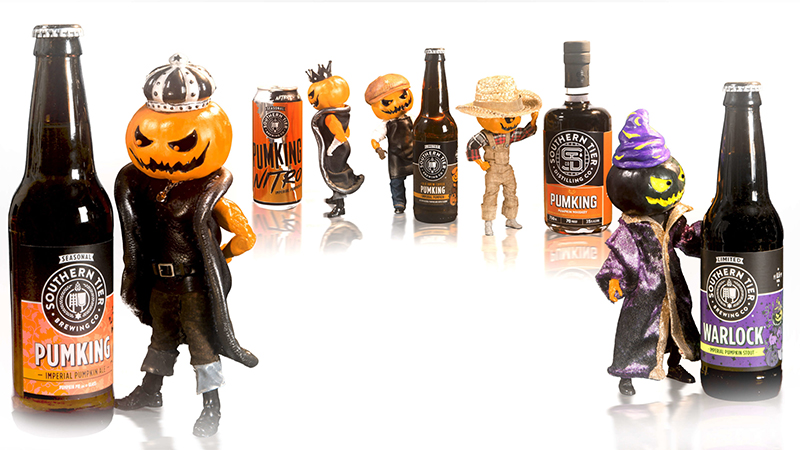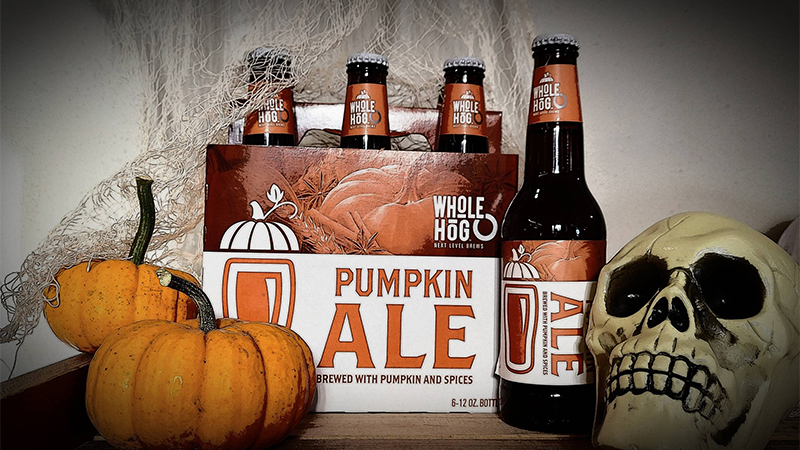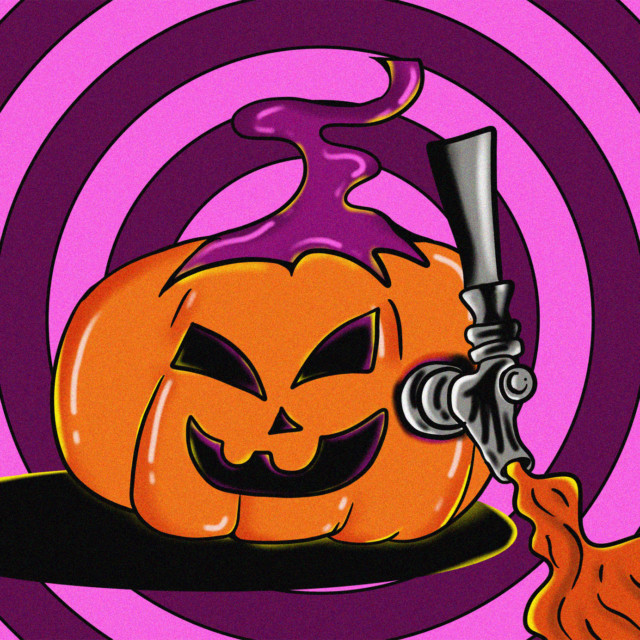This October, VinePair is celebrating our second annual American Beer Month. From beer style basics to unexpected trends (pickle beer, anyone?), to historical deep dives and new developments in package design, expect an exploration of all that’s happening in breweries and taprooms across the United States all month long.
After exploding in popularity in the early 2010s as the world of craft beer began its own exponential growth, pumpkin ales became, just as quickly, the biggest joke in craft beer.
As early as 2013, Buzzfeed News was asking which side of the debate you fell onto, following a controversial BeerAdvocate retweet of someone calling pumpkin beers “the mullet of craft beers.” Things got worse in 2015, when Anheuser-Busch chose to punch down at craft beer in its infamous Super Bowl ad, and it used a pumpkin beer to do it. (OK, technically a pumpkin-peach.)
Now that the American brewing community has matured (a bit) and the fall seasonal world has mostly moved on to Oktoberfest adoration, where do these pie-spiced ales stand in today’s craft beer landscape? Is there a squash-ale stasis, or are we seeing brewers slowly return to the style that has more or less stagnated for years?

In the broadest sense, Google Trends shows an annual spike in pumpkin beer interest every October, and there’s been a slow but steady uptick since bottoming out in the middle of the decade. As of now, 2021 is currently trending to have the highest search interest since October 2015. It’s a small indicator of a resurgence, but an indicator nonetheless. We looked into some numbers provided by Chicago-based market research firm IRI, but since it doesn’t track pumpkin beers as a style, we’re choosing instead to look at some anecdotal evidence from the category leaders.
To get a better feeling for where the world of pumpkin beers is today, we reached out to a couple of authorities in the field, one responsible for the nation’s most popular pumpkin beer (Southern Tier’s Pumking) and one responsible for many awards (Whole Hog’s Pumpkin Ale).
We also wanted to see what brought one of the nation’s most innovative, interesting breweries to make its very first pumpkin beer this year: Off Color Brewing’s Pumpkin Beer for Cafes. It’s a weird time for pumpkin beers; let’s find out how things are panning out for the pros.
The Pumpkin Beer Powerhouse: Southern Tier’s Pumking
If you noticed an overall dip in pumpkin beer midway through the last decade, no one felt that more than Phin DeMink. As co-founder of Southern Tier, home to the category-leading 8 percent imperial pumpkin beer known as Pumking, DeMink experienced the contraction of the category first hand. “A few years back … it was just pumpkin everything,” he says. “It went a little over the top, between the candles and Starbucks and cereal.” The result for pumpkin beer peddlers: “We went through this pumpkin beer exodus. … There was definitely a big fallout.”
DeMink estimates that they lost nearly 20 percent of their pumpkin beer volume during that mid-decade seasonal backlash — not insignificant when you consider that, per DeMink, “if you just looked at IRI, there were a couple of years where we outsold the category.” Pumking is indeed a powerhouse, and has recently spawned a variety of other products, including Warlock (a pumpkin stout), Pumking nitro, and cold brew coffee Pumking nitro. There’s even Pumking whiskey plus a “King & Cola” RTD through its distillery arm.
All those line extensions aside, it’s been a good time for Pumking prime as of late. “We were one of the few [breweries] that was like hey, everybody’s been eating pumpkin pie forever, Thanksgiving isn’t going away,” DeMink says. “We’re gonna just stick to our guns and weather the storm. We saw a couple of years where competition was growing leaps and bounds. And [then] that whole pack went back to Oktoberfests. So the last couple of years for us, everything’s been really, really healthy.”
DeMink estimates that year over year, they’re up by double digits just for Pumking alone. “We were kind of anticipating that this was probably going to be a comeback year,” he says. For a company that starts spinning up the Pumking machine as early as May in order to meet demand, it’s good to see the renewed enthusiasm for a seasonal product that’s really only got about a two-month window to make the lion’s share of its sales.
“It’s in a great spot,” DeMink said. “But it’s funny, because now all of a sudden I’m seeing pumpkin beer starting to pop up again.”
The Critically Praised Pumpkin Beer: Whole Hog’s Pumpkin Ale
If you use medals from the Great American Beer Fest as a generally well-regarded metric of quality, the annual Pumpkin Ale from Whole Hog Beer in Stevens Point, Wis., is head and shoulders above every other pumpkin beer in the nation. In fact, it might be one of the most highly awarded beers in America. Since its release in 2011, the beer has medaled five times at GABF, including two gold medals.

Mike Schraufnagel has been along for the entire ride, having worked at the brewery for 13 years, including the last three as its brewmaster. Whole Hog’s pumpkin ale has remained the same beer since some final tweaks in 2012, and aside from a brief foray into a barrel-aged option in 2015, remains the standard bearer for what an excellent pumpkin beer should be.
Per Schraufnagel, there’s never been a better time for Whole Hog’s pumpkin beer than this one. “It had a heck of a year, it really did,” he says, praising some new logistical advances on the distributor side that allowed Whole Hog to get a better sense of demand. “We [went] into the year thinking, OK, we need 23 brews of it this year and we can fulfill all the pre-sale orders. Whereas in the past, we started out with 10 brews and just kind of, you know, put our ear to the ground to see what the feedback was, and hoped that we’d end up [selling] a good number of them.”
Logistics aside, the appetite for the Whole Hog’s Pumpkin Ale is there in spades: Sales increased roughly 25 percent since last year, and the brand has moved over 2,100 barrels of its pumpkin beer in 2021 so far (up 600 barrels from the previous year) with most of them out the door by late August. “As the numbers were coming in for the pre-sales I was like, ‘This can’t be right,’” Schraufnagel says. “Right now it would be hard to find a bottle anywhere.”
Pumpkin Beer’s Modern Progression: Off Color’s Pumpkin Beer for Cafes
Chicago’s Off Color Brewing has made its name since 2013 as one of the nation’s most well-known experimental breweries. From leading the way for fruited goses and funky farmhouse ales, and self-created styles like “tiki-weisses” and Russian-style “serf stouts,” to its experiments with wild yeasts, foeders, and puncheon-aged beers, Off Color beers often push the limits. But it also loves classic lagers and the occasional pastry stout, as evidenced by its DinoS’mores series of beers.
With all that in mind, it’s either outrageous or inevitable that Off Color would produce a pumpkin beer, which it did for the first time this summer, in the form of its chai-vanilla-infused Pumpkin Beer for Cafes. Co-founder and brewer Dave Bleitner said it was just the right time for an Off Color pumpkin beer to enter the landscape.
“We don’t want to do stuff that’s prevalent. And I think we found more recently that everything’s gone so radical. You know, to one end there’s the haze craze, and then [on] the other end the Zima phase,” he says of the recent spate of sparkly, fruity beverages emerging from breweries. “It’s like, well what about … beers that are good?” Bleitner says. “We would joke, “Oh yeah, let’s do a historical style that was from the ‘90s.”
But why pumpkin beer, a style that has so fallen out of favor? “I guess it was uncool enough for us to do it now,” Bleitner says.
Off Color’s Pumpkin Beer for Cafes is based on its original “Beer for Cafes” which features chai spices on top of a rich, malty beer. Bleitner says that making a pumpkin chai was a natural next step, blending red rooibos tea with cinnamon, nutmeg, cloves, pumpkin puree, and vanilla to make a beer that was definitely pumpkin-forward but undeniably Off Color.
“I try not to make stuff that I wouldn’t drink, and there’s not a lot of pumpkin beers out there that I seek out,“ Bleitner says. “They’re either overly sweet, … overly boozy, or overly spiced, and I’ve never really had one that was well balanced.” It came along at the right time, apparently: Even though Off Color brewed the biggest-ever batch of its annual Oktoberfest, “the pumpkin beer outpaced it by like, 50 percent,” Bleitner says.
“We actually ended up with more in-house for to-go sales than I originally intended to have,” he says. “We had a hundred-something cases and I was like, ‘That seems like a lot for this.’ And we blew through it.”
Unfortunately, it came along too late for one potential patron. “Last year we had somebody come into the bar and say, ‘I’ll take your pumpkin beer,’” Bleitner says. “We said, ‘We don’t make a pumpkin beer.’ And then, they left. ‘Ooooookay.’”
Good news for that guy: It looks like the market’s coming back to meet him.
This story is a part of VP Pro, our free platform and newsletter for drinks industry professionals, covering wine, beer, liquor, and beyond. Sign up for VP Pro now!
